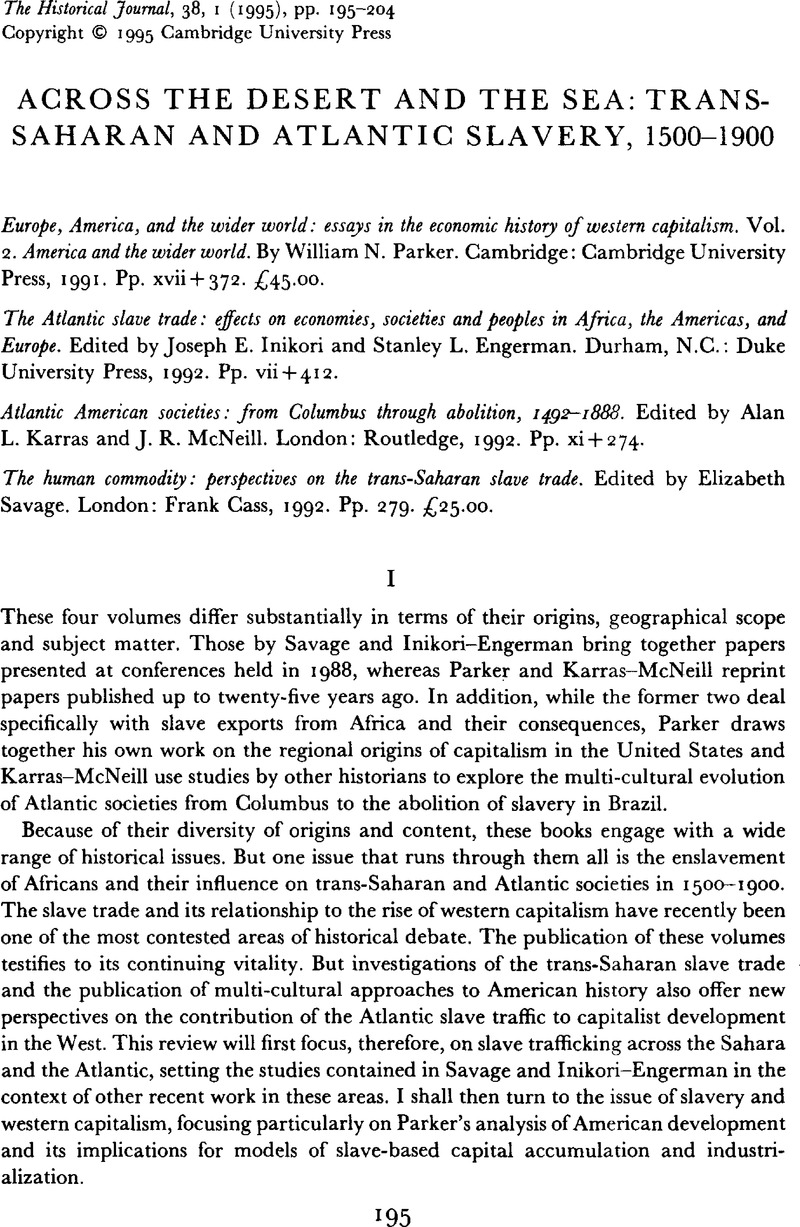Article contents
Across the desert and the sea: trans-Saharan and Atlantic slavery, 1500–1900
Published online by Cambridge University Press: 11 February 2009
Abstract

- Type
- Review Articles
- Information
- Copyright
- Copyright © Cambridge University Press 1995
References
1 Curtin, P. D., The Atlantic slave trade: a census (Madison, Wisconsin, 1969)Google Scholar. For summaries of recent research findings see Lovejoy, P. E., Transformations in slavery (Cambridge, 1983), ch. 3, 7Google Scholar; idem, ‘The impact of the Atlantic slave trade on Africa: a review of the literature’, Journal of African History, XXX (1989), 365–94.Google Scholar
2 Lovejoy, P. E. and Hogendorn, J. S., Slow death for slavery: the course of abolition in northern Nigeria, 1897–1936 (Cambridge, 1993).CrossRefGoogle Scholar
3 On the general contours of the Atlantic trade, see Lovejoy, Transformations; Eltis, D., Economic growth and the ending of the transatlantic slave trade (Oxford, 1987)Google Scholar, appendix A.
4 Eltis, D., ‘Free and coerced transatlantic migrations: some comparisons’, American Historical Review, LXXXVIII (1983), 251–80.CrossRefGoogle Scholar
5 The latest evidence on the Red Sea and East African slave trades is reviewed in The economics of the Indian Ocean slave trade of the nineteenth century, ed. Clarence-Smith, W. G. (London, 1989).Google Scholar
6 The excerpt reprinted in Karras–McNeill is from Manning, P., Slavery and African life: Occidental, Oriental and African slave trades (Cambridge, 1990).Google Scholar
7 The selection from Crosby reprinted in Karras-McNeill comes from Crosby, A. W., Ecological imperialism: the biological expansion of Europe, 900–1900 (Cambridge, 1986).Google Scholar
8 Eltis, D., ‘Europeans and the rise and fall of African slavery in the Americas: an interpretation’, American Historical Review, XCVIII (1993), 1399–1423.CrossRefGoogle Scholar
9 See Russell-Wood, A. J., ‘Colonial Brazil: the gold cycle, c. 1690–1750’, in The Cambridge History of Latin Amenca, ed. Bethell, L. (Cambridge, 1984), II, 547–600Google Scholar; Miller, J. C., Way of death: merchant capitalism and the Angolan slave trade 1730–1830 (London, 1988), ch. 12.Google Scholar
10 The excerpt from Morgan comes from his ‘The labor problem at Jamestown, 1607–18’, American Historical Review, LXXVI (1971), 595–611Google Scholar; that Wood from his Black majority (New York, 1976).Google Scholar
11 For evidence on the composition of the Atlantic slave trade see Eltis, D. and Engerman, S. L., ‘Was the slave trade dominated by men?’, Journal of Interdisciplinary History, XXIII (1992), 239–415Google Scholaridem, ‘Fluctuations in sex and age ratios in the transatlantic slave trade, 1663–1864’, Economic History Review, XLVI (1993), 308–23.Google Scholar
12 For evidence on mortality see Eltis, , Economic growth, pp. 265–9Google Scholar; Klein, H. S., The middle passage (Princeton, 1978), pp. 55–7, 84–5, 162, 195–200CrossRefGoogle Scholar; Postma, J. M., The Dutch in the Atlantic slave trade 1600–1815 (Cambridge, 1990), pp. 248–58.CrossRefGoogle Scholar
13 These issues are discussed at length in Fogel, R. W., Without consent or contract: the rise and fall of American slavery (New York, 1989), ch. 5.Google Scholar
14 There are similar arguments about politics, Islam and slave raiding in Klein's contribution on the Atlantic slave trade and western Sudan in Inikori–Engerman (pp. 35–8).
15 Davis, R., The industrial revolution and British overseas trade (Leicester, 1979), 88–125.Google Scholar
16 On the general expansion of trans-Saharan activity see Austen, R. A., ‘Marginalization, stagnation, and growth: the trans-Saharan caravan trade in the era of European expansion, 1500–1900’, in The rise of merchant empires: long-distance trade in the early modem world 1350–1750, ed. Tracy, J. D. (Cambridge, 1990), pp. 311–50.CrossRefGoogle Scholar
17 Eltis, , Economic growth, pp. 9–13Google Scholar. See also Drescher, S., Econocide: British slavery in the era of abolition (Pittsburgh, 1977).Google Scholar
18 Williams, E., Capitalism and slavery (London, 1964 edition), ch. 5Google Scholar; Greene, L. J., The negro in colonial New England (New York, 1942), pp. 68–9.Google Scholar
19 Williams, , Capitalism and slavery, p. 105.Google Scholar
20 Anstey, R., The Atlantic slave trade and British abolition 1760–1810 (London, 1975), pp. 48–51CrossRefGoogle Scholar; Engerman, S. L., ‘The slave trade and British capital formation in the eighteenth century: a comment on the Williams thesis’, Business History Review, XLVI (1972), 430–43CrossRefGoogle Scholar. See also P., O'Brien, ‘European economic development: the contribution of the periphery’, Economic History Review, XXXV (1982), 3–9.Google Scholar
21 Solow, B. L., ‘Caribbean slavery and British growth: the Eric Williams hypothesis’, Journal of Development Economics, XVII (1985), 99–115.CrossRefGoogle Scholar
22 Fogel, , Without consent or contract, p. 81.Google Scholar
23 See, for example, Fogel, , Without consent or contract, p. 101.Google Scholar
24 Fogel, , Without consent or contract, p. 103.Google Scholar
25 Women and children were also vital to early industrial growth in Britain; see Hudson, P., The Industrial Revolution (London, 1992), pp. 225–32Google Scholar; Berg, M., The age of manufactures 1700–1820 (London, second edition, 1994), ch. 7.Google Scholar
26 Fogel, , Without consent or contract, pp. 110–11.Google Scholar
27 See, for example, Dunn, R. S., ‘Sugar production and slave women in Jamaica’, in Cultivation and culture: labor and the shaping of slave life in the Americas, eds. Berlin, I. and Morgan, P. D. (Charlottesville, Virginia, 1993), pp. 49–72.Google Scholar
- 2
- Cited by




